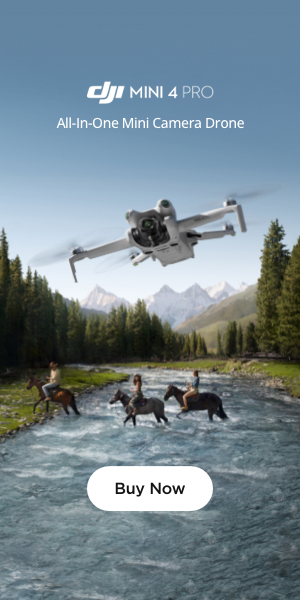Just purchased the Mini 5 Pro (and I loved it), and the Mavic 4 Pro - Creator Combo (just unboxed it). I am surprised the M4PRO does not come with ND filters. I remember reading something about eND filters (virtual filters - i.e., software-driven). Who is an authority on this topic and can help me understand if I need to purchase ND filters or not?
You are using an out of date browser. It may not display this or other websites correctly.
You should upgrade or use an alternative browser.
You should upgrade or use an alternative browser.
Do I need an ND filter for Mavic 4 Pro?
- Thread starter marwan_zakaria
- Start date
AMann
Well-Known Member
neutral density filters are useful if you are shooting bright things and can’t expose them correctly - like sunsets or white snow or light sand… software cannot fix overexposed parts of an image, there is simply no data for them to pull out.- just white. That’s when neutral density filters are useful.
If you don't know, that's an indication that you probably don't need ND filters.Who is an authority on this topic and can help me understand if I need to purchase ND filters or not?
hank970
Well-Known Member
I think ND filters are useless if you plan to shoot stills only. Camera sensors are biased to assume an overall scene reflectance of 18%. If you put on an ND filter. the camera will simply interpret the scene as too dark and will adjust shutter speed to still yield 18% reflectance. If the scene is so bright that the highest shutter speed isn't fast enough to prevent washed out highlights, then select a lower ISO. (Actually, the sensor will think the scene is too bright and will select a faster shutter speed to yield 18% reflectance. The images of things that should be dazzling white, like sunlight on snow, will look like they're gray. As a rule, when shooting bright stuff like snow or a white-sand beach, you should open the aperture or select a lower shutter speed to let in more light to avoid that gray look.)
Video is a different matter. ND filters are useful if you want to achieve much slower shutter speeds to yield cinematic blur.
Video is a different matter. ND filters are useful if you want to achieve much slower shutter speeds to yield cinematic blur.
AMann
Well-Known Member
White snow or sand in an aerial can blow out as white, even with fast shutter speeds and low ISO’s. They also let you use a narrower depth of field by using a larger aperture opening if you want to blur the background in a still.I think ND filters are useless if you plan to shoot stills only. Camera sensors are biased to assume an overall scene reflectance of 18%. If you put on an ND filter. the camera will simply interpret the scene as too dark and will adjust shutter speed to still yield 18% reflectance. If the scene is so bright that the highest shutter speed isn't fast enough to prevent washed out highlights, then select a lower ISO. (Actually, the sensor will think the scene is too bright and will select a faster shutter speed to yield 18% reflectance. The images of things that should be dazzling white, like sunlight on snow, will look like they're gray. As a rule, when shooting bright stuff like snow or a white-sand beach, you should open the aperture or select a lower shutter speed to let in more light to avoid that gray look.)
Video is a different matter. ND filters are useful if you want to achieve much slower shutter speeds to yield cinematic blur.
Plus if you want movement blur in your photo such as water or a vehicle you might need an ND filter depending on lighting conditions.White snow or sand in an aerial can blow out as white, even with fast shutter speeds and low ISO’s. They also let you use a narrower depth of field by using a larger aperture opening if you want to blur the background in a still.
Ralph thompson
Well-Known Member
A small correction, ND filters are used for still photography, often in order to get a soft blur on water falls, rapids and sea scapes. There are many reasons to use ND filters and polarizers for artistic reasons. And with the amazing ability of modern drones to hold position, a slow shutter speed is handy for dynamic effects like moving cars, ships or aircraft.I think ND filters are useless if you plan to shoot stills only. Camera sensors are biased to assume an overall scene reflectance of 18%. If you put on an ND filter. the camera will simply interpret the scene as too dark and will adjust shutter speed to still yield 18% reflectance. If the scene is so bright that the highest shutter speed isn't fast enough to prevent washed out highlights, then select a lower ISO. (Actually, the sensor will think the scene is too bright and will select a faster shutter speed to yield 18% reflectance. The images of things that should be dazzling white, like sunlight on snow, will look like they're gray. As a rule, when shooting bright stuff like snow or a white-sand beach, you should open the aperture or select a lower shutter speed to let in more light to avoid that gray look.)
Video is a different matter. ND filters are useful if you want to achieve much slower shutter speeds to yield cinematic blur.
AMann
Well-Known Member
Good point about using a drone as a tripod- I want to explore that idea with mine.A small correction, ND filters are used for still photography, often in order to get a soft blur on water falls, rapids and sea scapes. There are many reasons to use ND filters and polarizers for artistic reasons. And with the amazing ability of modern drones to hold position, a slow shutter speed is handy for dynamic effects like moving cars, ships or aircraft.
I also really like images by people who’ve used dark ND filters to remove people from busy places- or to make them look like wisps of fog. I’ve seen some really eerie and dramatic images using welders glass as a very dark ND filter. Some of the most striking long-exposure daylight images using ND filters that I remember are of apocalyptic city images in busy places that appear abandoned, some with one lone person in them (who must stay still during the entire exposure), and one taken at Auschwitz with ghostly streams of fog (people) going up and down the stairs and across the walkways.
Last edited:
PHZ
Well-Known Member
Doesn't the Mavic 4 Pro have an adjustable aperture? This could be very useful when you don't have ND filters available, or when you are shooting both photos and video in the same flight.
100% in agreementI think ND filters are useless if you plan to shoot stills only. Camera sensors are biased to assume an overall scene reflectance of 18%. If you put on an ND filter. the camera will simply interpret the scene as too dark and will adjust shutter speed to still yield 18% reflectance. If the scene is so bright that the highest shutter speed isn't fast enough to prevent washed out highlights, then select a lower ISO. (Actually, the sensor will think the scene is too bright and will select a faster shutter speed to yield 18% reflectance. The images of things that should be dazzling white, like sunlight on snow, will look like they're gray. As a rule, when shooting bright stuff like snow or a white-sand beach, you should open the aperture or select a lower shutter speed to let in more light to avoid that gray look.)
Video is a different matter. ND filters are useful if you want to achieve much slower shutter speeds to yield cinematic blur.
For that to work you'd need to use very long exposure of several seconds or even minutes with camera on tripod. While certainly interesting method, using a drone for this would pose a several challenges. The major one is the motion blur. Drones are by nature not as stable as camera on a tripod so any exposure longer than 1 sec will most likely introduce some level of motion blur. Despite some claiming to achieve "perfectly" sharp photos at long exposures with their drone. The limit is definitely somewhere around 1 sec from my experience, and even that could prove too long in windy conditions. And 1 sec might not be enough to achieve the desired effect of capturing busy places completely void of people.Good point about using a drone as a tripod- I want to explore that idea with mine.
I also really like images by people who’ve used dark ND filters to remove people from busy places- or to make them look like wisps of fog. I’ve seen some really eerie and dramatic images using welders glass as a very dark ND filter. Some of the most striking long-exposure daylight images using ND filters that I remember are of apocalyptic city images in busy places that appear abandoned, some with one lone person in them (who must stay still during the entire exposure), and one taken at Auschwitz with ghostly streams of fog (people) going up and down the stairs and across the walkways.
AMann
Well-Known Member
Sorry, totally disagree100% in agreement
My favorite ND filters to use, both on my F5 (when I used to shoot with film), and now on my DSLR and drone is a graduated ND filter. You can shoot really nice sunsets with them as the graduation (darker on top than in the bottom) gives you the ability to save details in the sky and keep the ground exposed nicely. It’s really nice in photos where there are city lights below and clouds in the sky that are brightly backlit.
Well, that is a different story. I do not think that was the question the OP asked. We usualy talk about normal ND filters here not gradation filters. I used graduated filters on my DSLR film camera too but those were the large rectangular polycarbonate ones and I had a special holder for them which allowed me to slide them up and down to get the transition in the right place according to the scene and composition of the shot. Now I just bracket and blend in post. More control and better resultsSorry, totally disagree
My favorite ND filters to use, both on my F5 (when I used to shoot with film), and now on my DSLR and drone is a graduated ND filter. You can shoot really nice sunsets with them as the graduation (darker on top than in the bottom) gives you the ability to save details in the sky and keep the ground exposed nicely. It’s really nice in photos where there are city lights below and clouds in the sky that are brightly backlit.
Last edited:
AMann
Well-Known Member
Yeah, those resin filters were fun, weren’t they? I also used to love shooting with a Wratten 2 Red filter for B&W, especially at desert rock art sites. It made the lines of the petroglyphs look like chalk against black rocks. There’s so much you can do with filters, I modified one of my Mavic 2 Pros for IR and that’s a fun one to play with.Well, that is a different story. I do not think that was the question the OP asked. We usualy talk about normal ND filters here not gradation filters. I used graduated filters on my DSLR film camera too but those were the large rectangular polycarbonate ones and I had a special holder for them which allowed me to slide them up and down to get the transition in the right place according to the scene and composition of the shot. Now I just bracket and blend in post. More control and better results
You’re right, I haven’t heard very many people talking about putting a graduated neutral density filter on a drone, it works really well, even better than using the graduated tool in Photoshop, but I really have to be careful to avoid that dreaded filter glare!
In those film days I needed to carry wooden box full of the color correction filters and color meter when shooting interiors with various light sources. It was very difficult to get the WB right on trannies. But that all changed with arrival of digital cameras. I still have the box somewhereYeah, those resin filters were fun, weren’t they? I also used to love shooting with a Wratten 2 Red filter for B&W, especially at desert rock art sites. It made the lines of the petroglyphs look like chalk against black rocks. There’s so much you can do with filters, I modified one of my Mavic 2 Pros for IR and that’s a fun one to play with.
You’re right, I haven’t heard very many people talking about putting a graduated neutral density filter on a drone, it works really well, even better than using the graduated tool in Photoshop, but I really have to be careful to avoid that dreaded filter glare!
UAVquadman
Well-Known Member
what a rude response! LOL maybe he is a beginner and would like to know.If you don't know, that's an indication that you probably don't need ND filters.
Tony Blaszak
Member
I noticed a big improvement on sunny days when I installed my polarizing filter.
It's not rude at all, I was being brief.what a rude response! LOL maybe he is a beginner and would like to know.
Here I'll give you a longer version.
When you understand enough about ND filters, what they can do for you and whether what you are doing with the drone would benefit from using ND filters, then you'd be in a position to tell for yourself.
But if you don't already have that understanding, then you don't need UV filters for your drone.
The use of ND filters is much hyped in forums like this, causing beginners to assume they need to use UV filters even if they don't.
Last edited:
UAVquadman
Well-Known Member
For video work it's best to have them. I'm not doing so great now as I just had a very expensive dental implant 5 days ago and it's still painful. I kind of regret having it done but only time will tell. I never use ND filters on my Mavic 3 drones when I'm only taking photos. thanks for the nice response.It's not rude at all, I was being brief.
Here I'll give you a longer version.
When you understand enough about UV filters, what they can do for you and whether what you are doing with the drone would benefit from using UV filters, then you'd be in a position to tell for yourself.
But if you don't already have that understanding, then you don't need UV filters for your drone.
The use of UV filters is much hyped in forums like this, causing beginners to assume they need to use UV filters even if they don't.
hank970
Well-Known Member
Yes, and in this digital age, it's also easier to eliminate transient and intrusive human elements (in a landscape or architectural shot, for example), by stacking and processing multiple images. I can also use stacking to "calm" choppy water or convey a sense of movement in flowing water, though I think those latter effects have become rather tired and overused. If, as Ansel Adams noted, art in photography involves production of the equivalent, then producing an ethereal, silky, milky flow of water as it tumbles over rocks really isn't equivalent to what our eyes see in real time.In those film days I needed to carry wooden box full of the color correction filters and color meter when shooting interiors with various light sources. It was very difficult to get the WB right on trannies. But that all changed with arrival of digital cameras. I still have the box somewhere. Same with graduated ND filters. It is so much easier today to AEB and use masks and blending methotds in post to achieve the desired outcome.
Owing to its inherent instability, a drone is not really suited to either of those techniques, whether fitted with ND filters or not, but I suppose a person could try shooting a quick burst of shots and process them to achieve a result.
Similar threads
- Replies
- 3
- Views
- 597
- Replies
- 6
- Views
- 360
- Replies
- 12
- Views
- 6K
- Replies
- 1
- Views
- 2K
DJI Drone Deals
Members online
Total: 3,902 (members: 13, guests: 3,889)










